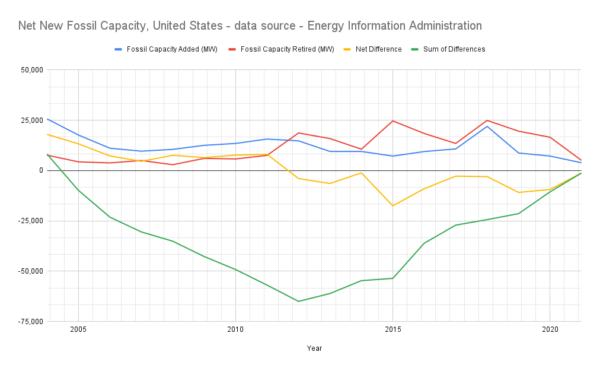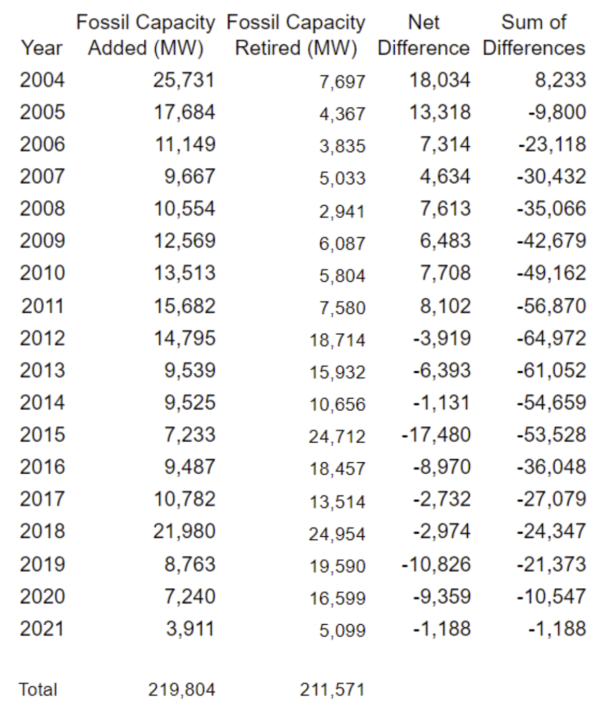Since sometime in late 2004, the United States has retired more fossil fuel capacity than it has built, according to the Energy Information Administration (EIA). During that period, the nation has seen cumulative solar power capacity grow from about 500 MW to 100 GW at the start of 2021.
Additionally, since 2011 through the end of 2020, the percentage of electricity from CO2 free sources has increased from 31% to greater than 41%; meanwhile, the percentage from solar and wind power alone has increased from less than 3% to greater than 11%.

The data come from EIA Form 860m, the “Preliminary Monthly Electric Generator Inventory.” To create the above chart, we added all new fossil facility capacities (blue line)–organized by new operating year in the “Operating” tab of the EIA 860m form–and then subtracted all retired fossil facilities based on when the year they closed (red line).
The yellow line is the annual net difference, which has been negative since sometime in 2012. Cumulatively, starting this year and looking backwards, if we subtract the retired fossil capacity from the new fossil capacity, we have to go all the way back to 2005/2004 before we see a net increase in fossil facility construction in the U.S.
Overall, during this roughly 18-year period, the U.S. has built 219 GW of fossil capacity, while retiring 211 GW.
 More importantly, however, the power grid has been generating more clean electricity. The EIA’s Electric Power Monthly’s total electricity generation figures go back to 2011. Over the past decade, annual electricity demand remained between 4 to 4.2 million MWh.
More importantly, however, the power grid has been generating more clean electricity. The EIA’s Electric Power Monthly’s total electricity generation figures go back to 2011. Over the past decade, annual electricity demand remained between 4 to 4.2 million MWh.
Electricity generated by fossils dropped from 2.78 million MWh to 2.4 million, while renewables increased from 121 thousand to 470 thousand MWh — growing from 3% to over 11%.
Globally in 2020, and seemingly for the first time, the “entirety of new power generation growth in 2020 came from wind, solar, and hydropower,” according to Bloomberg New Energy Finance. Roughly 200 GW of that growth came from a combined wind and solar power.
And on December 1, the International Energy Agency announced that renewables are set to account for almost 95% of the increase in global power capacity through 2026, with solar PV alone providing more than half.
In 2022, the United States is projected to massively increase its solar and wind generating capacity. S&P Global Market Intelligence recently said that we will install 44 GW of new solar and 27 GW of new wind in 2022.
That would almost double last year’s record solar capacity deployment of approximately 23 GW, which itself was almost 50% higher than 2016’s prior record of approximately 14 GW.
This content is protected by copyright and may not be reused. If you want to cooperate with us and would like to reuse some of our content, please contact: editors@pv-magazine.com.








By submitting this form you agree to pv magazine using your data for the purposes of publishing your comment.
Your personal data will only be disclosed or otherwise transmitted to third parties for the purposes of spam filtering or if this is necessary for technical maintenance of the website. Any other transfer to third parties will not take place unless this is justified on the basis of applicable data protection regulations or if pv magazine is legally obliged to do so.
You may revoke this consent at any time with effect for the future, in which case your personal data will be deleted immediately. Otherwise, your data will be deleted if pv magazine has processed your request or the purpose of data storage is fulfilled.
Further information on data privacy can be found in our Data Protection Policy.